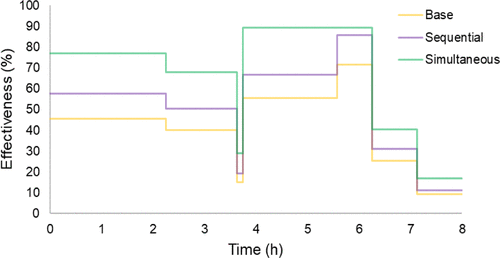当前位置:
X-MOL 学术
›
Ind. Eng. Chem. Res.
›
论文详情
Our official English website, www.x-mol.net, welcomes your
feedback! (Note: you will need to create a separate account there.)
Integrated Optimization Framework for the Design and Scheduling of Batch Cooling Water Networks
Industrial & Engineering Chemistry Research ( IF 3.8 ) Pub Date : 2021-06-01 , DOI: 10.1021/acs.iecr.1c00812 Victor Dippenaar 1 , Thokozani Majozi 1
Industrial & Engineering Chemistry Research ( IF 3.8 ) Pub Date : 2021-06-01 , DOI: 10.1021/acs.iecr.1c00812 Victor Dippenaar 1 , Thokozani Majozi 1
Affiliation

|
Cooling water system (CWS) research traditionally focuses on the interactions between the cooling water network (CWN) and cooling tower performance, with a continuous background process. Very limited research has considered the integration of batch production and utility systems. This work presents a mathematical framework for the synthesis and optimization of a CWS consisting of multiple cooling towers operating with a batch background process. The CWN exhibits a series configuration, which is characterized by cooling water reuse. A batch CWS superstructure is developed which represents all different pairings between the cooling towers and the batch background network. It is worth mentioning that in previous research, the utilization of cooling water reuse opportunities was constrained by temperature only; however, due to the nature of batch processing, the utilization of cooling water reuse opportunities is subject to both temperature and time constraints. The benefits of this research for retrofit design is the increase in cooling tower availability. In the case of grassroots design, the capital expenditure for cooling tower capacity is reduced. The mathematical model is developed as a mixed-integer nonlinear programming (MINLP) problem within the GAMS platform. The MINLP is solved by making use of the BARON solver ensuring global optimality. Two illustrative examples are presented. Results indicate a 0.45% increase in the annual profit, a reduction of 42.1% in the total recirculating cooling water requirement, and a 25.3% increase in the average overall cooling tower effectiveness. Capital costs and plant area savings were introduced through a reduction in the number of cooling towers required from 3 to 2. The makeup water consumed was also reduced by 6.3%; this reduced the operational costs and plant water footprint. One of the drawbacks of the model presented is the computational time requirement. Future work will address this concern by implementing decomposition and investigating the use of alternative batch background scheduling formulations.
中文翻译:

用于批量冷却水网络设计和调度的集成优化框架
冷却水系统 (CWS) 研究传统上侧重于冷却水网络 (CWN) 与冷却塔性能之间的相互作用,并具有连续的背景过程。非常有限的研究考虑了批量生产和公用事业系统的集成。这项工作提出了一个用于合成和优化由多个冷却塔组成的水煤浆的数学框架,该冷却塔以批处理背景工艺运行。CWN 具有串联配置,其特点是冷却水回用。开发了一个批处理 CWS 上层结构,它代表了冷却塔和批处理背景网络之间的所有不同配对。值得一提的是,在以往的研究中,冷却水回用机会的利用仅受温度的限制;然而,由于批处理的性质,冷却水回用机会的利用受到温度和时间的限制。这项改造设计研究的好处是提高了冷却塔的可用性。在基层设计的情况下,冷却塔容量的资本支出减少。数学模型被开发为 GAMS 平台内的混合整数非线性规划 (MINLP) 问题。MINLP 是通过使用确保全局最优的 BARON 求解器来求解的。提供了两个说明性示例。结果表明,年利润增加了 0.45%,循环冷却水总需求量减少了 42.1%,冷却塔整体效率平均提高了 25.3%。通过将所需的冷却塔数量从 3 个减少到 2 个,引入了资本成本和工厂面积节省。消耗的补充水也减少了 6.3%;这降低了运营成本和工厂水足迹。该模型的缺点之一是计算时间要求。未来的工作将通过实施分解和调查替代批次背景调度公式的使用来解决这一问题。
更新日期:2021-06-17
中文翻译:

用于批量冷却水网络设计和调度的集成优化框架
冷却水系统 (CWS) 研究传统上侧重于冷却水网络 (CWN) 与冷却塔性能之间的相互作用,并具有连续的背景过程。非常有限的研究考虑了批量生产和公用事业系统的集成。这项工作提出了一个用于合成和优化由多个冷却塔组成的水煤浆的数学框架,该冷却塔以批处理背景工艺运行。CWN 具有串联配置,其特点是冷却水回用。开发了一个批处理 CWS 上层结构,它代表了冷却塔和批处理背景网络之间的所有不同配对。值得一提的是,在以往的研究中,冷却水回用机会的利用仅受温度的限制;然而,由于批处理的性质,冷却水回用机会的利用受到温度和时间的限制。这项改造设计研究的好处是提高了冷却塔的可用性。在基层设计的情况下,冷却塔容量的资本支出减少。数学模型被开发为 GAMS 平台内的混合整数非线性规划 (MINLP) 问题。MINLP 是通过使用确保全局最优的 BARON 求解器来求解的。提供了两个说明性示例。结果表明,年利润增加了 0.45%,循环冷却水总需求量减少了 42.1%,冷却塔整体效率平均提高了 25.3%。通过将所需的冷却塔数量从 3 个减少到 2 个,引入了资本成本和工厂面积节省。消耗的补充水也减少了 6.3%;这降低了运营成本和工厂水足迹。该模型的缺点之一是计算时间要求。未来的工作将通过实施分解和调查替代批次背景调度公式的使用来解决这一问题。











































 京公网安备 11010802027423号
京公网安备 11010802027423号